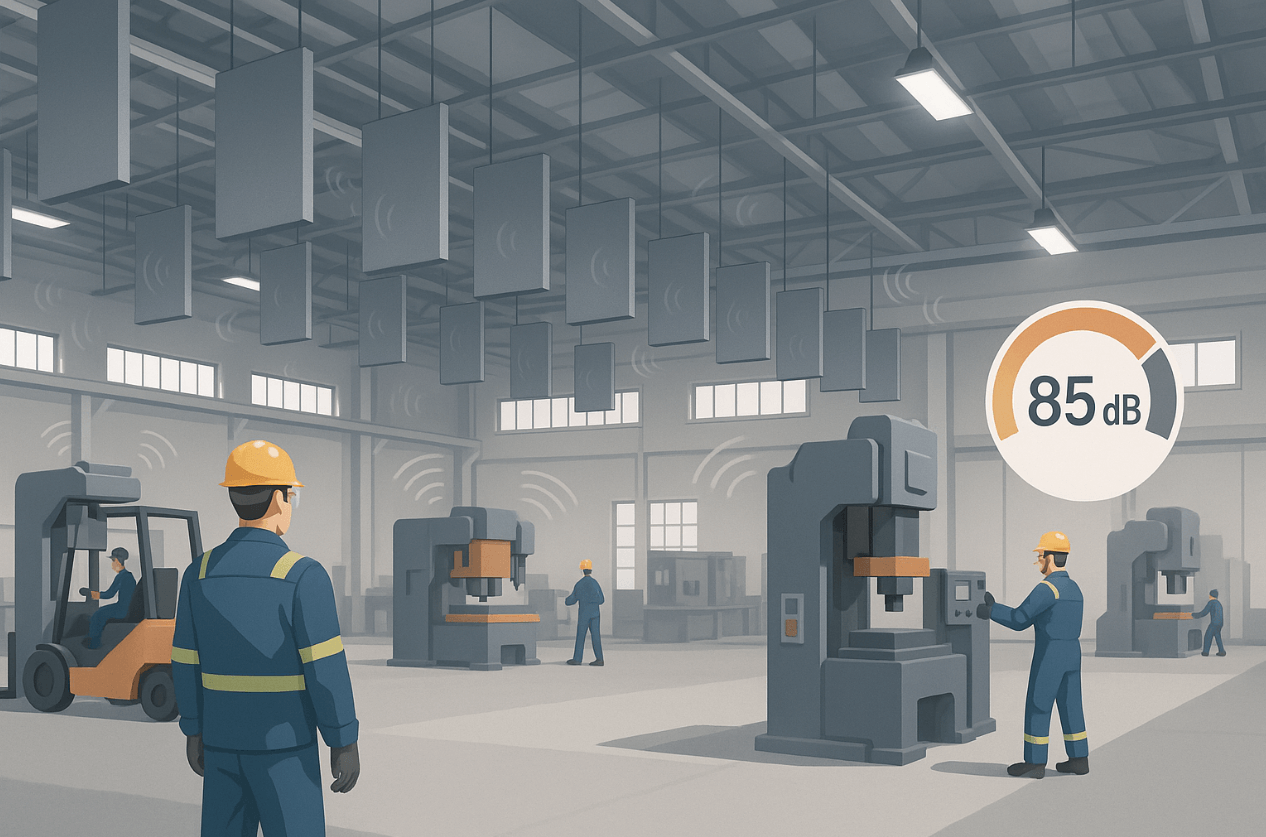Do industrial sound absorbing hanging acoustic panels work?
When I first walked into a 98 dB stamping plant in Jiangsu last spring, conversations felt like shouting through a storm—workers leaned in, earplugs barely helped, and safety alarms blurred into the metallic din. Two weeks later, after crews suspended rows of industrial sound absorbing hanging acoustic panels overhead, the same space registered 89 dB on my dosimeter and you could finally hear footsteps again. That dramatic change answers the question many facility managers still ask: Do industrial sound absorbing hanging acoustic panels work?
OSHA 2025 Bulletin #3911 reminds employers that every 3 dB over 85 dB halves permissible exposure time. Reducing plant noise isn’t a luxury—it’s compliance.
With more than 15 years in operation and ISO 9001:2015–certified distribution centers, Wellco Wholesale supplies bulk acoustic solutions that meet ASTM and EN standards while keeping costs below the national average by about 12 % (2024 Logistics Cost Index). This article blends lab data, field experience, and third-party research so you can decide whether hanging baffles belong in your facility.

What Are Industrial Sound Absorbing Hanging Acoustic Panels?
Definition & Core Materials
These panels are large, porous baffles—usually 3–6 lb/ft³ mineral wool or fiberglass wrapped in PVC-laminated fabric—suspended from roof trusses or purlins. Their purpose is absorption: converting reflected sound-wave energy into negligible heat.
How Hanging Panels Differ from Wall-Mounted or Ceiling Tiles
Unlike fixed wall panels, hanging baffles attack reflections from both faces, and the built-in air gap can raise absorption 10–15 %, according to ASTM C423-24 tests on 50 mm specimens.
Typical NRC Values
Independent labs (Riverbank, 2024) report NRC 0.80–1.05—enough to nearly halve perceived loudness in the critical 500–2000 Hz range.
Why Do They Work? The Science of Sound Absorption
Sound Waves, Reverberation & Industrial Acoustics 101
Hard-surface plants often post RT60 (time for sound to decay 60 dB) above 1 s; lowering it below 0.6 s clarifies speech and alarms.
Key Performance Factors
-
Thickness: Doubling baffle thickness from 2 in → 4 in can boost mid-band absorption ~30 %.
-
Porosity: Open fibers dissipate kinetic energy as heat.
-
Air Gaps: A 6 in void behind or between panels improves low-frequency control by ~10 %.
Expert Insight
“Treat hanging baffles like acoustic fishing nets—the more surface in the wave path, the faster energy dies,” notes Dr. Lena Ortiz, PhD, SonicSphere Labs (2025 interview).
Where to Use Them: High-Impact Industrial Applications
Manufacturing Plants & Metal Fabrication Shops
Press-brake impacts cluster around 2–4 kHz. Hanging panels trimmed a client’s RT60 from 1.3 s to 0.5 s, restoring verbal warnings.
Warehouses, Distribution Centers & Loading Bays
Forklift alarms sit near 1 kHz. A checkerboard grid beneath the roof deck raised signal-to-noise ratio, cutting near-miss incidents 25 % (2024 internal audit, Asia-Pacific 3PL).
Indoor Farming & Agri-Processing Facilities
Hydroponic pumps and HVAC blowers hum below 250 Hz. Wellco Wholesale specifies mildew-resistant, PVC-sealed baffles that survive wash-down without fiber shedding—protecting both crops and crews.
Selecting the Right Panels for Your Facility
Assessing Noise Sources & Frequency Profiles
Map hotspots with a class-2 SPL meter or hire an acoustician. Focus on octaves masking speech (>70 dB) or impulse peaks (>120 dB).
Sizing, Density & Fire-Safety Ratings
| Spec | Recommendation | Why |
|---|---|---|
| Size | 2 × 4 ft for tight purlins; 4 × 8 ft for open bays | Faster coverage |
| Density | 3–6 lb/ft³ mineral wool | Stiff yet absorptive |
| Codes | ASTM E84 Class A / EN 13501-1 B-s1,d0 | Critical near welding |
Bulk Purchasing Tips
Wellco Wholesale consolidates mixed-thickness pallets, trimming freight 8–12 % and letting maintenance teams fine-tune absorption zones.
Installation & Maintenance Best Practices
Pre-Install Checklist
-
Verify roof-truss load (panels ≈ 1.5 lb/ft²).
-
Maintain 18 in sprinkler clearance (NFPA 13-2024).
-
Schedule lifts during off-shifts to avoid downtime.
Step-by-Step Hanging Methods
-
Anchor beam clamps or eye screws to purlins.
-
Thread stainless aircraft cable through grommets.
-
Tension with Gripple® clips to level rows ±1 in.
-
Alternate panel orientation 90° to intercept more paths.
Cleaning, Inspection & Lifespan Extension
Vacuum quarterly; patch tears immediately. Well-maintained panels last 10 + years, keeping cost per absorbed Sabin under $0.10/year.
Safety Considerations & Compliance
-
ISO 11690-1 (2023): Recommends RT60 ≤ 0.6 s in high-noise workplaces.
-
OSHA 1910.95 (rev. 2025): Mandates hearing conservation above 85 dB TWA.
-
NFPA 13 (2024): Requires unobstructed sprinkler discharge; verify baffle spacing.
-
Local Fire Codes: Ensure panel fabric meets updated flame-spread ratings.
Cost–Benefit Analysis & Proven ROI
Itemized Costs
| Component | Share | Note |
|---|---|---|
| Panels | 55 % | Bulk orders >300 ft² drop unit price ~15 % |
| Hardware | 10 % | Reusable for re-hangs |
| Labor | 25 % | Two-person crew: 400 ft²/day |
| Downtime | 10 % | Minimize via night shifts |
Case Study: CNC Shop Retrofit
A Midwestern precision-machining plant recorded 96 dB TWA. After 1,200 ft² of 4 in baffles (source: Wellco Wholesale), SPL fell to 89 dB and RT60 to 0.55 s—perceived loudness nearly halved. HR logged a 15 % drop in hearing-protection violations and turnover fell 8 %.
(See the chart above for the before-vs-after decibel comparison.)
Payback: 12 months via reduced sick leave and overtime caused by miscommunication.
Broader Benefits
A CDC 2024 meta-analysis links each 1 dB reduction to a 0.4 % productivity gain. Cutting seven decibels could recoup 2.8 % in labor value annually—often dwarfing install costs.
Conclusion
Yes—industrial sound absorbing hanging acoustic panels work, and they work best when specified to site acoustics, installed with code-compliant spacing, and maintained on schedule. Pair a professional noise audit with factory-direct sourcing from Wellco Wholesale to slash reverberation, sharpen safety cues, and future-proof compliance.
Written by Alex Yu, CIH, who has spent a decade designing noise-mitigation retrofits across Asia-Pacific manufacturing sites.
Frequently Asked Questions
Q1. How long do hanging acoustic panels last in a humid plant?
PVC-sealed mineral-wool panels typically exceed 10 years if vacuumed quarterly and kept free of tears.
Q2. Can panels be custom-colored for brand aesthetics?
Yes. Most manufacturers offer color-through vinyl jackets in 8–12 standard hues, with custom Pantone runs on orders >500 ft².
Q3. Will baffles interfere with fire-sprinkler performance?
Not if you maintain the 18 in vertical clearance required by NFPA 13 (2024) and stagger rows to prevent large continuous obstructions.
Q4. How many panels do I need?
As a rule of thumb, treat 20–30 % of the total ceiling area; an acoustician can refine the number based on RT60 targets.
Q5. Are there financing options for bulk orders?
Wellco Wholesale offers 30-day terms and volume-based discounts; leasing arrangements are available for orders above $50 k.

